Top Dressing Lawn with Compost – How to Top Dress Your Lawn the Right Way
Top dressing lawn with compost is one of the principal lawn care techniques that can help a homeowner achieve a lush green grass that will make their lawn the envy of the neighborhood. However, getting to this point requires a bit of work and good care and maintenance.
Top dressing your lawn with compost is one of the most effective ways of ensuring that your lawn remains healthy and beautiful. It involves spreading a thin layer of compost on top of the grass. The application only requires ¼ to ½ of an inch of compost, which, when done correctly, can provide your lawn with medium to slow-release nutrients that promote optimum grass growth. Below, we will delve into the concept of top dressing and detail the numerous benefits that come with it, including increased moisture retention and better drainage.
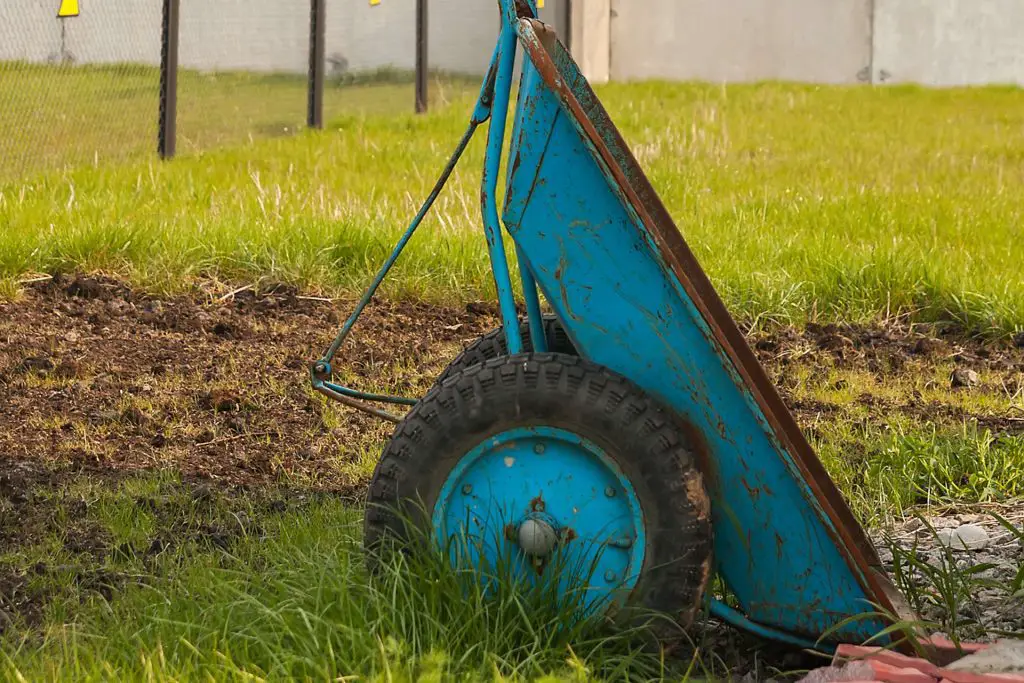
So why should you top-dress your lawn? Well, doing so is the best way of improving the overall health of your turf grass and the soil beneath it. By top dressing, you provide a steady stream of organic matter that nourishes the soil and encourages the growth of soil organisms that are beneficial to grasses. Additionally, top dressing makes your lawn more resistant to pests and better equipped to choke out weeds. It encourages a deep root system that can better withstand drought and nurtures the beneficial soil microbes that help grasses thrive.
In the following sections, we will explore the benefits of top dressing your lawn, when to do it, and how to go about it using different techniques. So, whether you’re caring for a well-established lawn or one in the early stages of development, this article is sure to provide you with the information necessary to achieve your ideal lawn.
What is Top Dressing a Lawn?
Top dressing a lawn entails adding a layer of organic matter, such as compost, to the top of your grass. Typically, only ¼ to ½ an inch of compost is needed. The compost can be spread manually or using a broadcast spreader.
Once the compost has been spread over the grass, it will eventually make its way down into the soil, either through rainfall, wind, soil organisms, or human actions, such as mowing or raking. The compost settles in and around the grass roots, enriching the soil and providing valuable nutrients that promote healthy grass growth improving the grass root structure.
Top dressing provides numerous benefits to the overall health of your lawn. Since it adds to the organic matter in the soil, it helps to improve the soil quality, thereby enhancing the soil’s water-holding capacity, drainage, and nutrient-holding ability.
Additionally, top-dressing a lawn helps to reduce thatch buildup in the soil, which is a layer of decomposing organic material that can accumulate over time and suffocate grass roots. By reducing thatch buildup, top dressing encourages healthy grass growth and improves root development.
One important thing to remember when top-dressing your lawn is to ensure that compost is spread evenly across the lawn. Uneven coverage can lead to imbalances in your lawn, with some areas receiving too much organic matter while others receiving too little. Using a broadcast spreader or raking the compost out evenly can help prevent this.
Overall, top-dressing a lawn is a simple and cost-effective way to improve the overall health of your lawn, promote healthy grass growth, and improve the quality of the soil beneath it. Below, we will explore the many benefits of top-dressing your lawn and how it can help improve the overall health and vigor of your grass.
Why Top Dress Your Lawn?
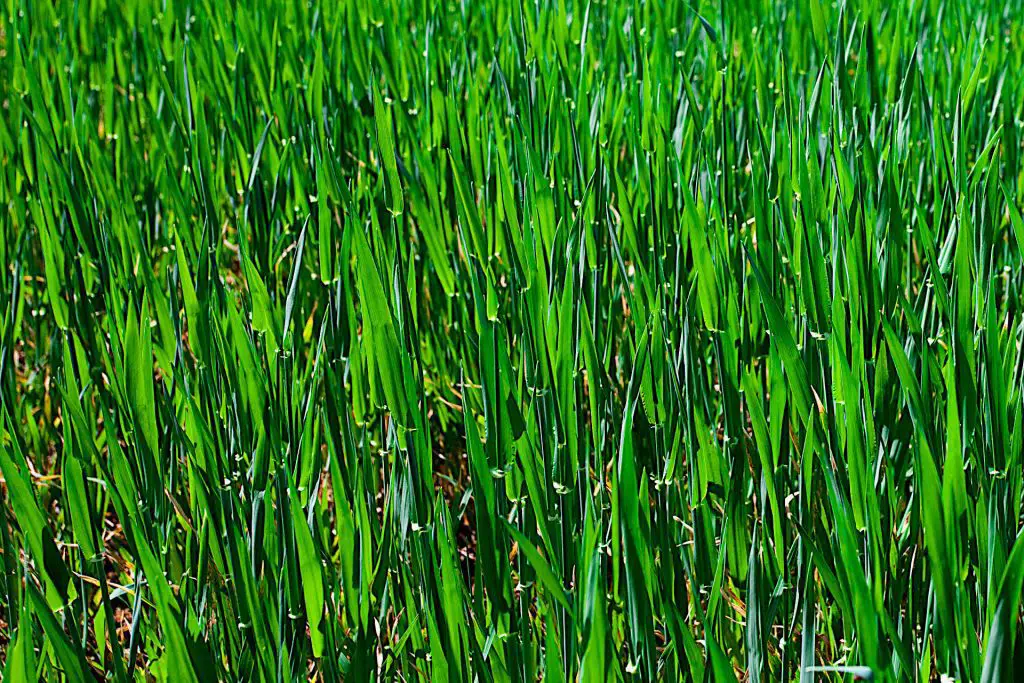
Top dressing your lawn is an essential part of lawn maintenance that has numerous benefits. As we have mentioned, the process of top dressing involves adding a thin layer of compost to the surface of a lawn. The benefits of top dressing a lawn include improving soil quality, increasing moisture retention, promoting better drainage, enhancing nutrient absorption, and improving the cation exchange capacity (CEC) of the soil.
Improves Soil Quality
One of the main benefits of top-dressing your lawn is that it improves soil quality. When top dressing, organic matter in the form of compost is added to the soil, which helps to improve its structure, texture, and fertility. This, in turn, helps to promote healthy root development and optimal nutrient uptake and delivers numerous other benefits to the soil. Ultimately, it should improve the soil structure and water-holding capacity while enhancing healthy microbe activity, which in turn helps your lawn to thrive.
Increases Moisture Retention
Another benefit of top-dressing a lawn is that it increases moisture retention. Organic matter has a high water-holding capacity, which means it can hold onto water and slowly release it into the soil as needed, thereby ensuring a steady supply of water for your lawn. This steady supply of water helps to sustain the grass roots, even in times of drought, and keeps your lawn looking healthy and vibrant.
Promotes Better Drainage
Top dressing also promotes better drainage. Adding compost to the soil helps to create pore spaces within the soil structure, allowing water to move freely through it. This is particularly important during heavy rains when water needs to be able to drain away from the surface quickly to prevent erosion, soil compaction, and excess moisture around the grass roots.
Enhanced Nutrient Absorption
Top dressing improves nutrient absorption by helping to make essential nutrients in the soil more readily available to the grass roots. Organic matter in compost is naturally high in minerals and trace elements, which are essential nutrients for healthy grass growth.
Increase in cation exchange capacity
Moreover, top dressing enhances nutrient absorption and helps to improve the cation exchange capacity (CEC) of the soil. CEC refers to the soil’s ability to attract, hold, and exchange nutrients with the grass roots. Organic matter has a high CEC, which means it can hold onto nutrients like nitrogen, phosphorus, and potassium (NPK), making them more available to the roots of the grass.
Helps with Resistance to Pests and Diseases
Top-dressing a lawn also improves its resistance to pests and lawn diseases, promotes deeper root systems, and nurtures beneficial soil microbes that help grasses thrive. It’s one of the best things you can do to improve the overall health of your lawn, and it’s relatively easy and straightforward to do.
Carbon Sequestration
Increased Carbon Sequestration: By adding organic matter to the soil through top dressing, the carbon in that organic matter is stored in the soil, resulting in increased carbon sequestration. This helps to reduce the impact of atmospheric carbon, which has implications for climate change globally.
Overall, top-dressing your lawn has numerous benefits for soil quality, water retention, drainage, nutrient absorption, and carbon sequestration. With proper care and maintenance, your lawn is sure to thrive.
In the next section, we’ll explore how to go about top-dressing your lawn, including the tools you’ll need and the steps involved.
Best Times for Top Dressing Lawn by Climate Zone
Timing is everything, especially when it comes to lawn care. Top dressing your lawn can yield fantastic results, but doing it at the wrong time can lead to less-than-stellar outcomes.
Why Timing Matters
Choosing the right time for top dressing is crucial for maximizing nutrient absorption and encouraging robust growth. The timing affects how well the soil can integrate the compost, leading to better water retention and soil aeration.
Climate Zone Breakdown
Temperate Zones
In temperate zones, the best time for top dressing is during the spring and fall. These seasons offer moderate temperatures and adequate rainfall, creating ideal conditions for soil improvement.
Tropical Zones
For those living in tropical climates, the rainy season is the most suitable time for top dressing. The ample rainfall helps in compost decomposition and allows the nutrients to seep deep into the soil.
Arid Zones
In arid or desert climates, it’s best to top dress your lawn at the onset of the milder seasons, either in late fall or early spring. This timing ensures that the soil can absorb as much moisture as possible before the harsh weather sets in.
Cold Zones
In colder climates, aim for late spring or early summer. The ground should be fully thawed, and the grass should be in its active growing phase.
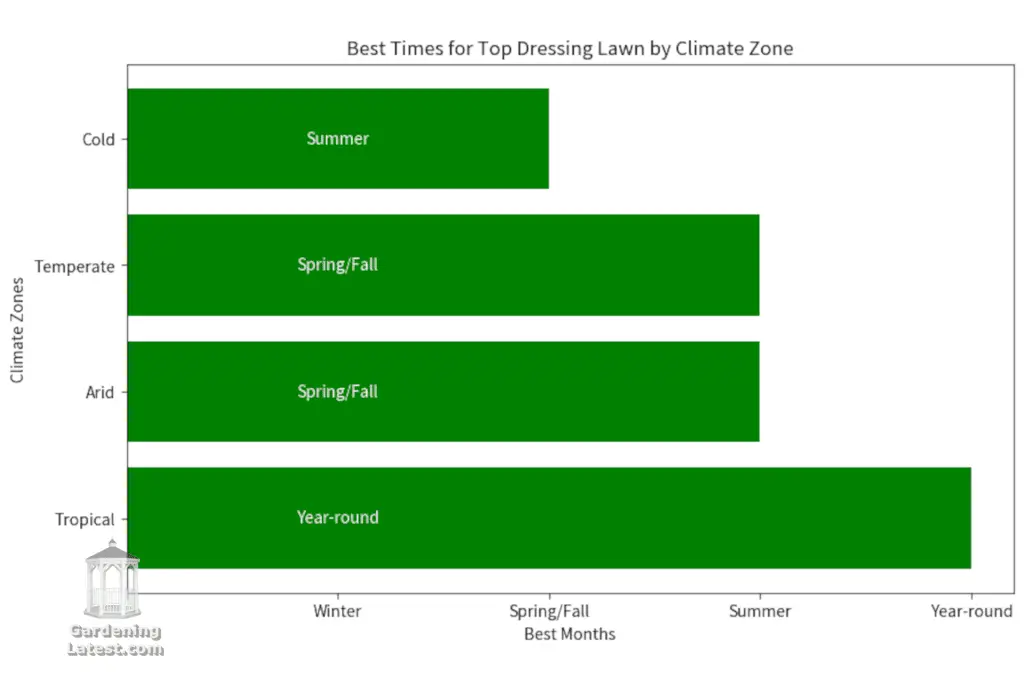
Key Factors to Consider
- Soil Temperature: Ensure the soil temperature is above 55°F for optimal microbial activity.
- Grass Type: Different grass types have different growing seasons, which can affect the best time for top dressing.
| Climate Zone | Best Time for Top Dressing |
|---|---|
| Temperate | Spring and Fall |
| Tropical | Rainy Season |
| Arid | Late Fall or Early Spring |
| Cold | Late Spring or Early Summer |
Additional Tips
- Weather Forecast: Always check the weather forecast before you begin. Avoid top dressing if heavy rains or extreme temperatures are expected.
- Soil Test: Conduct a soil test to determine the nutrient needs of your lawn, which can influence the type of compost you should use.
Knowing the best times for top dressing your lawn based on your climate zone is crucial for achieving a lush, healthy lawn. Whether you live in a temperate, tropical, arid, or cold climate, timing your top dressing correctly can make all the difference in your lawn’s health and appearance.
By being mindful of your climate zone and considering key factors like soil temperature and grass type, you can make the most out of this beneficial lawn care practice.
Equipment Required for Top Dressing Your Lawn

the success of your Top dressing application can largely depend on the equipment you use. There are a number of essential tools and equipment required for top dressing, to ensure that your lawn receives the best treatment possible. Below we will look at each one in turn.
The Must-Have List
- Compost Spreader: This is the star player in your top dressing game. A compost spreader ensures even distribution of compost across your lawn, eliminating the risk of clumps that can smother grass.
- Wheelbarrow: A sturdy wheelbarrow is indispensable for transporting compost from your compost pile to various parts of your lawn.
- Garden Rake: This tool is crucial for leveling the compost once it’s been spread. It helps in breaking down compost clumps and ensuring a smooth, even layer.
- Shovel: You’ll need a good shovel for loading compost into your wheelbarrow and spreader.
- Gloves: Last but not least, a pair of durable gloves will protect your hands during the process, making it a more comfortable experience.
Why Each Equipment Matters
| Equipment | Purpose |
|---|---|
| Compost Spreader | Even distribution |
| Wheelbarrow | Transport compost |
| Garden Rake | Level compost |
| Garden Fork/Aerator | Aerate the lawn |
| Shovel | Load compost |
| Gloves | Hand protection |
Compost Spreader
The compost spreader is the cornerstone of effective top dressing. It ensures that the compost is evenly spread, which is vital for uniform grass growth and soil aeration. Opt for a rotary spreader for larger lawns and a drop spreader for more precise application.
Wheelbarrow
A wheelbarrow serves as your mobile compost station, allowing you to easily move large quantities of compost. This is especially useful if you have a large lawn or if your compost pile is situated far from the area you’re treating.
Garden Fork/Aerator
One essential step to aerate the soil opening it up and allowing the compost to penetrate the surface. A garden fork can aerate a lawn but can be hard work. Hiring or buying a core aerator will be helpful if you have large areas to cover and the aerating process, in addition, relieves any compactness in the soil in keeping grass healthy.
Garden Rake
A garden rake is not just for gathering leaves in the fall. In the context of top dressing, it’s your go-to tool for fine-tuning the compost layer. It helps you spread the compost evenly, ensuring that all areas of your lawn benefit from the added nutrients.
Shovel
A sturdy shovel is essential for transferring compost from your compost pile into your wheelbarrow or spreader. A shovel with a wide blade is most effective for this task.
Gloves
Never underestimate the importance of a good pair of gloves. They not only protect your hands from abrasions but also make the whole process more hygienic.
Additional Tools
- Measuring Tape: To calculate the square footage of your lawn, ensuring you apply the correct amount of compost.
- Soil Test Kit: Before you begin, it’s wise to test your soil’s pH levels and nutrient content to tailor your top dressing mix accordingly.
How to Top Dress Your Lawn with Compost
Step by Step: Top Dress Your Lawn with Compost
Now that you understand the benefits of top-dressing your lawn, it’s important to know how to do it properly. Here are the steps involved in top-dressing your lawn with compost:
- Mow your lawn: Start by mowing your lawn to your desired length. This will help the compost to cover the entire lawn evenly.
- Rake up any debris: Use a rake to remove any debris or leaves from the lawn. This will ensure that the compost is applied evenly and has direct contact with the soil.
- Aerate the lawn: Use a core aerator to create holes in the soil, allowing air, water, and nutrients to penetrate deeper into the soil and reduce soil compaction. Core aerating is particularly important for older or heavily used lawns.
- Spread the compost: Using either a shovel or a broadcast spreader, spread a thin and even layer of compost over the entire lawn, making sure that you apply enough to cover the grass blades but not too much that it suffocates them.
- Water the lawn: Once you have applied the compost, you need to make sure it reaches your soil. Water the lawn gently with a sprinkler, taking care not to wash away the compost.
- Overseeding: If you spot any bare spots while top-dressing your lawn, consider overseeding with a compatible seed. Spread the seed using a broadcast spreader, and apply starter fertilizer to promote the early development of new grass.
It is important to note that the amount of compost required per square foot depends on the specific garden needs and the texture of the soil. As a general rule, you should aim to top dress your lawn with ¼ to ½ an inch of compost.
To make top-dressing your lawn a breeze, ensure that you have the correct equipment. A quality broadcast spreader will ensure that you cover every inch of grass with an even layer of compost, and a core aerator will be helpful in keeping grass healthy.
What Materials to Use for Top Dressing Your Lawn
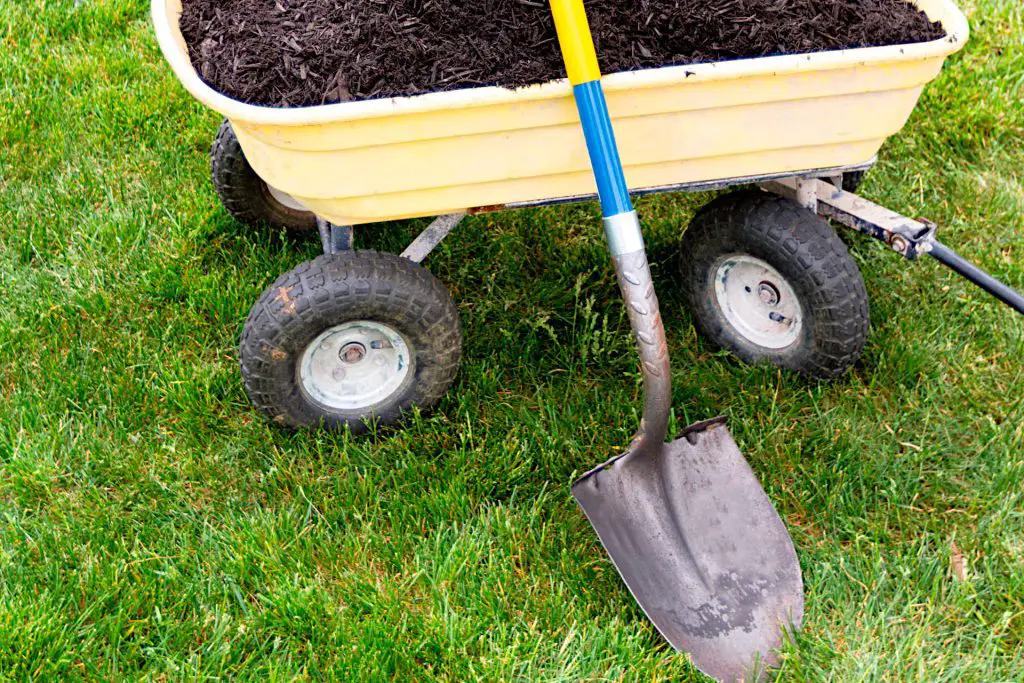
Materials Required for Top Dressing Your Lawn with Compost
When it comes to top-dressing your lawn, you have several options for materials to use. It’s important to choose the right material based on the existing soil and grass type. Here are some of the most common materials you can use for top-dressing your lawn:
- Compost: Compost is one of the most popular materials for top-dressing a lawn due to its rich nutrient content. It is a mixture of organic materials like leaves, trimmings, and grass clippings that have been decomposed over time, forming a fertilizer that can improve soil health.
- Loam: Loam is a mixture of sand, silt, and clay, and is an ideal material for top-dressing lawns with poor soil structure. It is well-draining and can improve soil fertility by introducing important nutrients like nitrogen, phosphorous, and potassium.
- Sand: Sand is a cheap and readily available material that can be used for leveling a bumpy lawn. However, too much sand can lead to soil compaction and poor soil structure, so it should be used in moderation and in combination with other materials.
It’s also important to note that when choosing a material for top dressing your lawn, it should be similar in texture to the underlying soil. This ensures that the layers form properly and reduces the risk of restricted water and air movement that can harm the roots of the grass.
It’s a good idea to mix different materials together to achieve the best results. Adding organic biostimulants, seaweed extract, fish emulsion, or plant hormones can improve soil nutrients and help to stimulate root growth. Broadcast spreaders can be used to distribute the materials over the lawn evenly.
Remember, before top-dressing your lawn, it’s important to monitor the soil moisture levels to ensure you don’t create harmful soil conditions. By regularly top-dressing your lawn, you can dramatically improve the soil structure and health, leading to better grass growth, as well as reducing the risk of thatching and weed-affected lawns.
Top Dressing Your Lawn Using Worm Castings
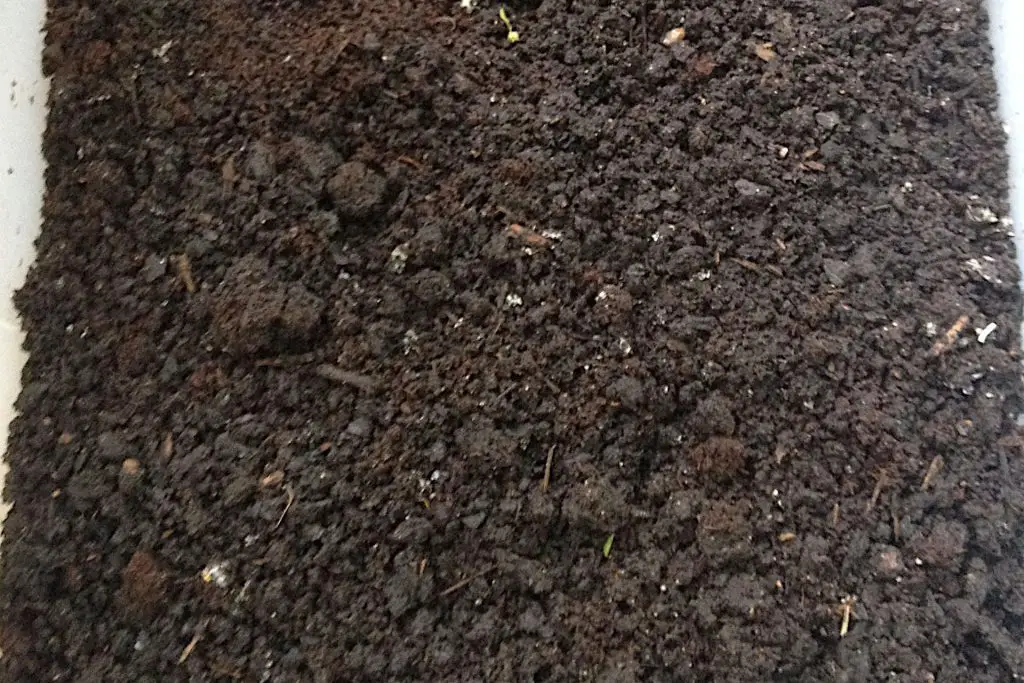
Using Earthworm castings for a lawn can be an alternative to traditional compost when top-dressing your lawn. This nutrient-rich, organic material offers a plethora of benefits that can transform your lawn into a lush, green paradise.
What are Earthworm Castings?
Earthworm castings are essentially the waste produced by earthworms as they consume organic matter in the soil. Far from being just “worm poop,” these castings are a powerhouse of nutrients, beneficial microbes, and organic matter. They are odorless, non-toxic, and safe for both pets and humans.
Benefits of Earthworm Castings
- Soil Structure Enhancement: Earthworm castings improve the physical structure of the soil, increasing its ability to retain water and nutrients.
- Nutrient-Rich: Packed with essential nutrients like nitrogen, phosphorus, and potassium, these castings provide a balanced diet for your lawn.
- Microbial Activity: The presence of beneficial microbes in the castings helps in breaking down organic matter, making nutrients more accessible to plants.
- Pest and Disease Resistance: The castings contain enzymes and beneficial microbes that deter pests and help prevent diseases.
How to Apply Earthworm Castings to Your Lawn
Applying earthworm castings is a straightforward process:
- Preparation: Mow your lawn and remove any debris.
- Application: Spread the castings evenly over the lawn using a shovel or a broadcast spreader.
- Incorporation: Lightly rake the castings into the soil or water them in.
- Frequency: For best results, apply every 4-6 weeks during the growing season.
Earthworm Castings vs Compost
While both are organic soil amendments, there are key differences:
- Nutrient Availability: Earthworm castings release nutrients more slowly compared to compost, providing a long-lasting nutrient supply.
- Ease of Use: Castings are easier to apply and less messy than compost.
- Quality Control: The nutrient content in earthworm castings is generally more consistent than in compost.
- Environmental Impact: Earthworm castings have a lower carbon footprint, making them a more sustainable choice.
Comparison of Earthworm Castings and Compost
| Criteria | Earthworm Castings | Compost |
|---|---|---|
| Nutrient Availability | Slow-release | Fast-release |
| Ease of Use | High | Moderate |
| Quality Control | Consistent | Variable |
| Environmental Impact | Low | Moderate |
Earthworm castings offer a compelling alternative to traditional compost topdressing. With their rich nutrient profile, ease of application, and environmental benefits, they are an excellent choice for anyone looking to elevate their lawn care practices.
Using Compost Tea as An Alternative to Compost
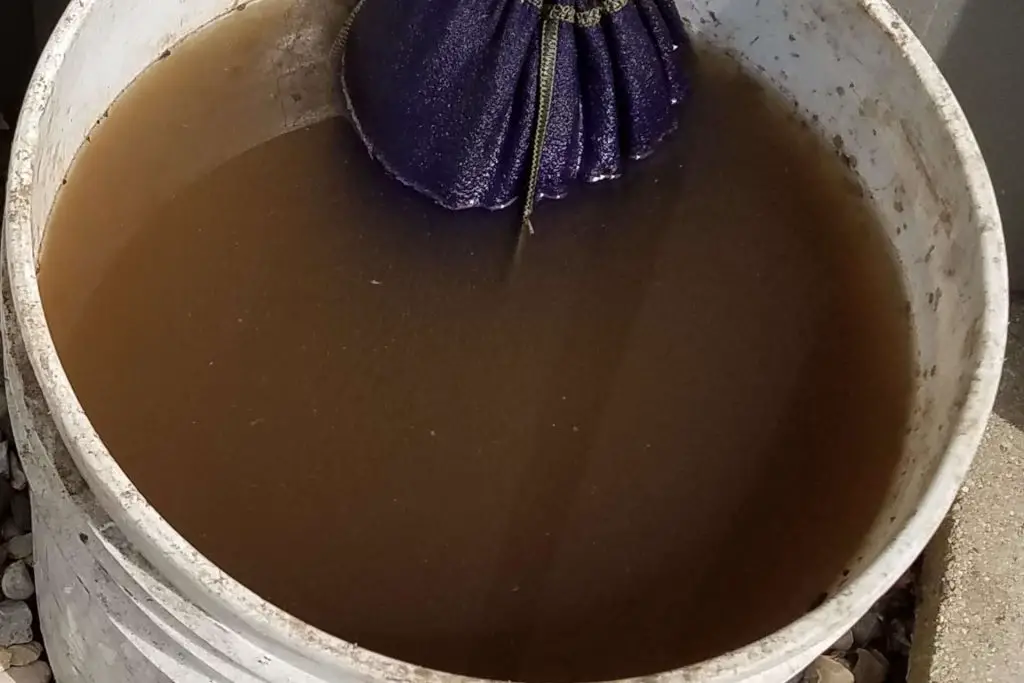
The objective of top dressing to to feed and enhance the health of your lawn and the soil below. Even with a good spreader the application process can be a laborious procedure. Liquid organic teas like Compost Tea and Earthworm Casting Tea offer a compelling, less labor-intensive alternative to traditional compost topdressing. With their ease of application and quick nutrient absorption, these teas are an excellent choice for those looking to simplify their lawn care routine without sacrificing quality.
What are Compost Tea or Earthworm Casting Tea?
Compost Tea and Earthworm Casting Tea are liquid extracts made from compost or earthworm castings, respectively. These teas are brewed to extract beneficial nutrients and microbes, creating a concentrated liquid that can be easily applied to your lawn. They are odorless, non-toxic, and safe for both pets and humans.
Liquid Organic Teas vs Compost
While compost and liquid organic teas both aim to enrich soil and promote plant health, they differ in several key aspects:
- Ease of Application: Liquid teas can be applied using a simple garden sprayer, making the process less labor-intensive than spreading compost.
- Nutrient Absorption: The liquid form allows for quicker nutrient uptake by plants.
- Microbial Diversity: Liquid teas often contain a broader range of beneficial microbes due to the brewing process.
- Storage and Shelf Life: Liquid teas have a shorter shelf life but take up less storage space.
Comparing Liquid Organic Teas and Compost
| Criteria | Liquid Organic Teas | Compost |
|---|---|---|
| Ease of Application | High | Moderate |
| Nutrient Absorption | Quick | Slower |
| Microbial Diversity | High | Moderate |
| Storage and Shelf Life | Less Space, Shorter | More Space, Longer |
How to Apply Liquid Organic Teas to Your Lawn
Applying these liquid organic teas is a straightforward process:
- Preparation: Mow your lawn and remove any debris. Make sure the soil is moist but not waterlogged.
- Brewing: If you’re making your own tea, brew it according to specific guidelines. Pre-made teas are also available.
- Application: Use a garden sprayer to evenly distribute the tea across your lawn. Make sure to cover all areas, focusing on spots that need extra attention.
- Post-Application Care: Water your lawn lightly to help the tea penetrate the soil.
- Frequency: Apply every 4-6 weeks during the growing season for optimal results.
Comparing Top Dressing Options
| Type of Compost | Nutrient Content | Ease of Application | Cost |
|---|---|---|---|
| Traditional Compost | High | Moderate | Low |
| Earthworm Castings | Medium | Easy | High |
| Compost Tea | Low | Easy | Medium |
These teas are brewed to extract beneficial nutrients and microbes, creating a concentrated liquid that can be easily applied to your lawn. They are odorless, non-toxic, and safe for both pets and humans.
Main Takeaways from Top Dressing Lawn with Compost
Top dressing your lawn with compost is a simple and effective way to improve the overall health and appearance of your lawn. Adding organic matter to the soil through top dressing can help improve the structure and fertility of the soil, enhance nutrient absorption, increase water retention, and provide an ideal environment for grass to grow.
To top-dress your lawn, you’ll need to mow it, rake up any debris, and aerate it. Then, spread your preferred mixture of compost, loam, or sand evenly over the lawn before watering it to encourage the material to penetrate the grass blades and facilitate nutrient absorption.
Choosing the right material is important to ensure that the turf performs well. You can also mix different types of materials to obtain a more balanced mixture and introduce organic matter and other nutrients via organic biostimulants, seaweed extract, fish emulsion, or plant hormones.
With a little bit of attention, you can make a huge difference in the quality of your lawn’s soil and, ultimately, have a healthier and more lush-looking lawn. Now that you know the benefits of top-dressing your lawn and how to go about it, you can get started and enjoy the benefits of improved soil structure, water retention, and healthy grass growth.
FAQs
| Question | Short Answer |
|---|---|
| What is top dressing? | A soil amendment technique. |
| How often should I top dress? | Once or twice a year. |
| Can I use any compost? | Use quality, organic compost. |
Q: What would be a suitable lawn top dressing?
A: Some of the common options for top-dressing your lawn include compost, loam, and sand. The choice of the material depends on the existing grass type and soil texture.
Q: At what time should the lawn be top-dressed?
A: The best time to top dress your lawn is during the growing season in spring or fall when the grass is actively growing. Avoid top dressing when the weather is wet or very hot as it can damage the grass.
Q: What is the significance of top-dressing a lawn?
A: Top dressing a lawn has numerous benefits, including improved soil quality, increased moisture retention, better drainage, enhanced nutrient absorption, improved cation exchange capacity (CEC), and increased carbon sequestration. It also makes your lawn more resistant to pests, and chalk out weeds while encouraging a deep root system that is better able to withstand drought.
Q: Is top dressing equivalent to topsoil?
A: No, top dressing is not equivalent to topsoil. Top soil is a layer of soil that is usually the top 2 to 8 inches of the ground, while top dressing refers to adding a thin layer of material like compost, sand or loam to the lawn surface to improve soil quality and support grass growth.
Further Reading
- Clemson University: Topdressing A Home Lawn
- The University of Tennessee: Turfgrass Maintenance Topdressing
